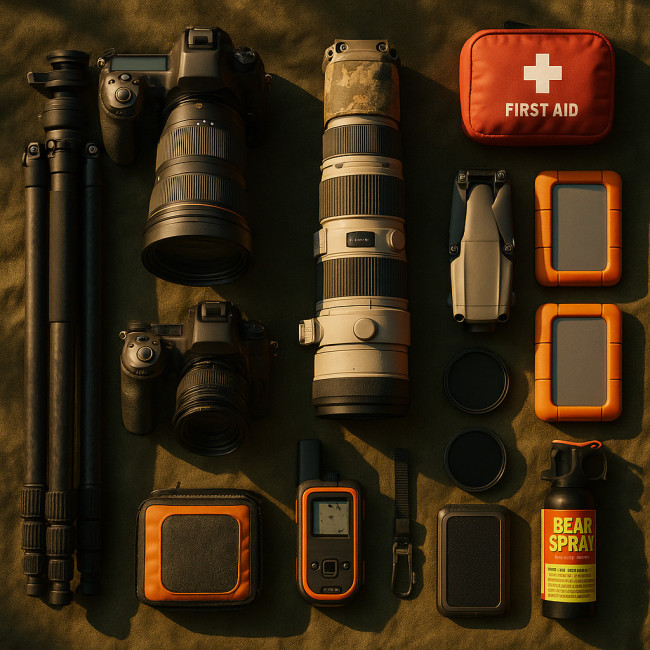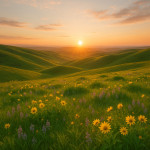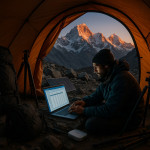How to Evaluate a Nature Photographer's Field Gear List Before Booking
Before you sign any contract, you must know whether a nature photographer's equipment can truly deliver the shots you have in mind. This guide shows you how to read a field gear list like a pro, from camera bodies to safety essentials, so you can book with confidence and avoid costly surprises.
Why the Field Gear List Matters
A nature shoot often takes place far from civilisation, where weather, wildlife and terrain shift quickly. If the photographer lacks the right kit—or packs too much of the wrong kit—images, deadlines and even crew safety are at risk. Evaluating the list up front:
- Confirms technical capability for your brief (macro, drone, low-light or high-speed action).
- Highlights hidden logistical costs such as additional baggage or permit fees.
- Reveals the photographer's professionalism and preparedness for emergencies.
Step-by-Step Gear Checklist

From rugged full-frame cameras clad in camouflage tape to carbon-fibre tripods standing beside waterproof dry bags, the full kit sprawls across a forest-stained canvas tarp. You should see dual-slot bodies paired with 600 mm primes, a macro lens resting on a lens plate, ND filters neatly aligned, drones folded, batteries numbered in marker, and a satellite communicator blinking ready. Visualise weather-proof hard cases stacked near solar chargers, silica gel sachets scattered among field notebooks and bear spray, each item telling a story of preparation, redundancy and respect for wild places. Pausing on such a scene for a moment helps you decide whether the list you are reading is exhaustive or merely aspirational.
1. Cameras & Sensors
Start with camera bodies and sensor sizes. Full-frame or APS-C sensors capture low-noise images in dim forest canopies, while micro four thirds may suffer at high ISO. Insist on:
- At least one weather-sealed body plus a back-up.
- Dual card slots for instant redundancy.
- Shutter counts under 200k for reliability.
2. Lenses Aligned to Your Subject
| Subject | Essential Focal Length | Recommended Aperture | Why It Matters |
|---|---|---|---|
| Wildlife | 300–600 mm | f/4–f/5.6 | Long reach without disturbing animals |
| Landscapes | 16–35 mm | f/4 | Edge-to-edge sharpness for vistas |
| Macro Flora | 90–105 mm | f/2.8 | 1:1 reproduction of small details |
| Aerial Scenes | 24–70 mm | f/2.8 | Versatile for drone or helicopter doors-off |
Ask for lens serial numbers on rental gear; mismatched copies affect colour and sharpness.
3. Tripods & Support
Carbon-fibre legs shave weight while absorbing vibrations. Confirm load ratings exceed the heaviest lens plus gimbal. A leveling base saves time on sloped terrain.
4. Drone Kit (If Applicable)
Drones expand creative angles but require permits and fail-safe planning. Ensure the list includes:
- Spare propellers and batteries (minimum three sets).
- ND filters to balance exposure at 1/50 s for cinematic motion blur.
- Remote ID compliance for 2025 regulations.
Still unsure about aerial rules? Our deep dive on drone regulations for outdoor shoots outlines permit lead times and insurance needs.
5. Data Management
Nothing stalls a campaign like lost files. Look for:
- Rugged SSDs with IP54 or higher rating.
- At least 1 TB per shooting day capacity.
- Dual-backup workflow: on-site clone plus cloud sync once back in signal.
6. Power & Weather Protection
River crossings, alpine ridges and desert heat each demand specialised weatherproofing. Verify:
- >Rain covers rated to 2000 mm hydrostatic head.
- Silica gel packs and lens wipes for humidity control.
- Portable solar panel or 100 W power bank for multi-day treks.
7. Personal & Wildlife Safety Gear
Field gear lists aren't only about cameras. A professional nature photographer also packs:
- First-aid kit tailored to remote areas (tourniquet, SAM splint, antihistamines).
- Bear spray or acoustic deterrents where wildlife warrants.
- Satellite communicator for SOS and weather updates.
For a broader safety perspective, review the questions in wildlife safety protocols to ask before hiring.
Red Flags on a Gear List
- One-camera shooters: no redundancy means one malfunction ends the project.
- All plastic tripods: low stability, poor durability and shaky long exposures.
- Lack of weatherproof storage: basic canvas bags soak through in minutes.
- Excessive kit: 40 kg+ packs slow movement and raise porter or transport fees.
Cost Implications You Might Overlook
Each extra kilogram can add 15–50 € in excess baggage on domestic flights and even more on charter aircraft. Additional gear also inflates insurance premiums. If you're coordinating a shoot in remote terrain, run numbers with our remote-project budgeting checklist.
Questions to Ask the Photographer
- “Which gear items are mission-critical, and which are backups?”
- “How do you power devices on multi-day treks?”
- “What is your data-backup routine in the field and post-shoot?”
- “Do you carry liability and equipment insurance that covers this region?”
- “Have you scouted seasonal light windows for our target shots?”
Quick Decision Matrix
| Gear Category | Must-Have | Nice-to-Have | Deal-Breaker If Missing |
|---|---|---|---|
| Camera Bodies | 2× weather-sealed | Third lightweight backup | Yes |
| Lenses | Coverage for planned focal lengths | Fast primes for creative b-roll | Depends on brief |
| Support | Carbon tripod | Motorised slider | No |
| Power | Spare batteries (2× per body) | Solar panel | Yes in winter |
| Data Backup | Rugged SSD + clone | On-site NAS | Yes |
| Safety | First-aid + comms | Dent puller for lens repair | Yes |
Mini Quiz: Test Your Gear List Savvy
FAQ
- Do I need to verify serial numbers on the gear list?
- Yes. Serial numbers confirm equipment ownership or authorised rentals and help you register insurance coverage.
- Is consumer insurance enough for a wilderness shoot?
- No. The photographer should carry professional liability and equipment insurance that covers remote locations and wildlife interaction.
- How early should we review the field gear list?
- At least three weeks before departure so you can adjust packing, permits and transport logistics.
- Where can I browse vetted nature photographers?
- Explore the full roster on the Nature Photographers directory to compare gear readiness, style and rates in one place.
Key Takeaways
- Match camera sensors, lenses and support to your creative brief.
- Demand redundancy for both imagery and data storage.
- Include safety, power and weather protection in your evaluation.
- Calculate hidden costs early—excess luggage, permits and insurance stack up fast.
Ready to book? Use the checklist above, cross-reference gear with your project needs and lock in a photographer who delivers breathtaking images without logistical headaches.











